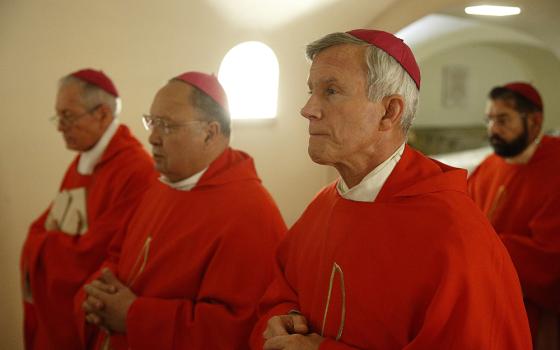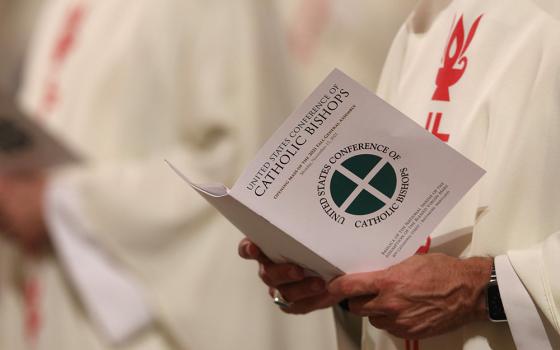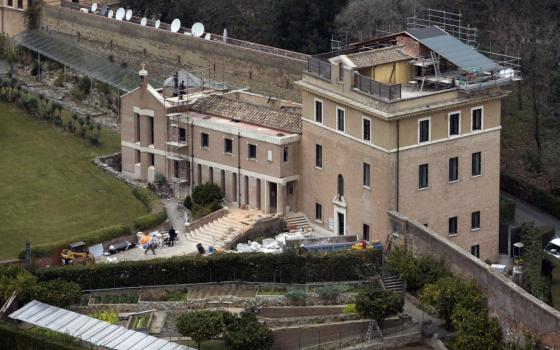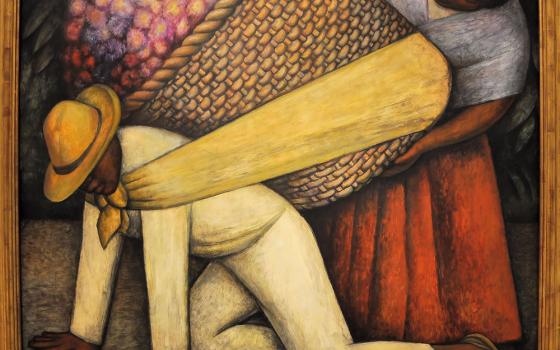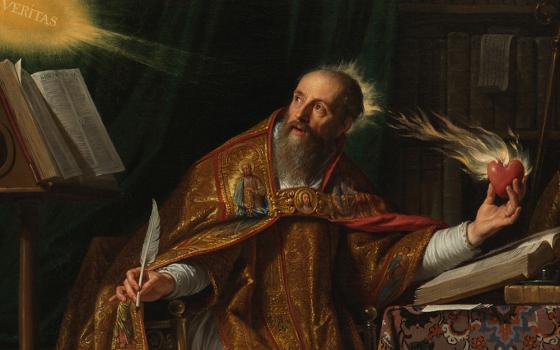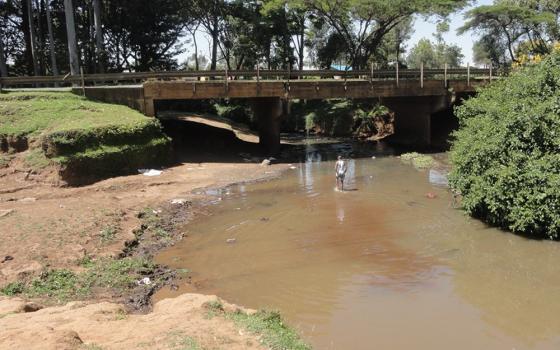Auxiliary Bishop Andrew Cozzens of St. Paul and Minneapolis carries the Eucharist in a monstrance during a procession June 19, 2021. Cozzens, now bishop of the Diocese of Crookston, Minnesota, is the lead organizer of the National Eucharistic Revival. (OSV News/CNS file/The Catholic Spirit/Dave Hrbacek)
I will admit to a certain reluctance in writing a column that could be interpreted as criticizing the spiritual practices and devotion of others. The Eucharist is — and has always been — an important source of nourishment for me. Yet I have serious misgivings about the amount of corporate time, money and energy that our U.S. bishops are devoting to their three-year National Eucharistic Revival, now entering its second year.
The mission of the bishops' revival is "to renew the Church by enkindling a living relationship with the Lord Jesus Christ in the holy Eucharist." To this end, the bishops initially budgeted a whopping $28 million dollars for a host of local and national educational sessions, processions and pilgrimages, culminating in a five-day national Eucharistic Congress that is expected to attract 75,000 people to Indianapolis next July. (Last fall, organizers announced that the budget had been cut in half.)
In his report to the June 15 U.S. bishops' conference assembly in Orlando, Bishop Andrew Cozzens described it as a "unique bishop-led evangelistic movement." One wonders if ordinary Catholics would have agreed with the revival's exorbitant budget had bishop leaders consulted them in synodal dialogue beforehand.
I worry that our bishops are more interested in pietistic spectacles than in facing inconvenient truths about eucharistic availability.
While there may be positive devotional outcomes for Catholics who participate in the revival, I can't help but worry that our bishops are inviting us to a massive exercise in cheap grace. As my friend Jesuit Fr. Tom Reese eloquently explains in a recent column:
Nowhere in the Gospels does Jesus tell his disciples to adore him. Rather, he directs our attention to his Father. Adoring Jesus in Benediction is OK, but it is not what the Mass is about . . . the Eucharist is not about me and Jesus; it is about us in the Christian community, about us being transformed into the body of Christ, about us joining in the mission of Jesus in the world.
Joining in the mission of Jesus is more than seeking devotional experiences, however inviting these may be. It is also working to change unjust societal and institutional structures so the marginalized and poor can thrive in the reign of God proclaimed by Jesus — and now by us — through the power of the Spirit. While the fourth part of the revival's parish segment briefly alludes to a "mission to the poor," the main goal is to bring people back to the institutional church.
I have no problem with piety, devotion and adoration. These sustain us as we work for the reign of God. Yet devotion is meaningless if sought for its own sake. Worse, I worry that our bishops are more interested in pietistic spectacles than in facing inconvenient truths about eucharistic availability.
In the 1990s, two highly regarded U.S. demographers, Richard Schoenherr and Lawrence Young, projected that by 2005 there would be a 40% decrease in the number of U.S. priests, while the number of Catholics would increase by 60%. At the time I was serving as the founding director of FutureChurch, whose seminal mission is to open ordination to all those called to it so as to preserve the Eucharist as the center of Catholic worship.
I have no problem with piety, devotion and adoration. These sustain us as we work for the reign of God. Yet devotion is meaningless if sought for its own sake.
Looking back, I well remember the optimism of those early years. Surely, we thought, by 2005 the bishops will come to their senses and put the eucharistic and pastoral needs of the people of God first. We expected church leaders to open ordination and reform the clerical system. That did not happen. Centuries of entrenched all-male leadership — one that not only distrusted women but apparently also distrusted men who loved women enough to marry one — would not easily change. Yet it was — and is — increasingly apparent that the Catholic Church desperately needs to expand those permitted to provide eucharistic ministry to her people.
Schoenherr and Young's projections proved devastatingly accurate, according to the Center for Applied Research in the Apostolate, or CARA. Between 1965 and 2022, the number of diocesan and religious order priests serving the U.S. church decreased by 42.2%, while the number of parish-connected Catholics increased by 50%. The diocesan priesthood is aging. In 2022 just 66% of diocesan priests were actively engaged in ministry compared to 75% percent in 2000. In 2000 there was one active diocesan priest per 2,795 Catholics. In 2022 that ratio had increased to one active diocesan priest per 4,179 Catholics.
New ordinations are woefully insufficient to offset priests who are retiring. Mary Gautier, the now-retired senior research associate at CARA, found that the U.S. church needs two to three times the annual number of diocesan ordinations to keep up with parish demand.
Bishop Andrew H. Cozzens of Crookston, Minn., chair of the U.S. Conference of Catholic Bishops' Committee on Evangelization and Catechesis, discusses the National Eucharistic Revival June 15 during the U.S. Conference of Catholic Bishops' spring assembly in Orlando, Fla. (OSV News/Bob Roller)
Worldwide statistics are scarcely better. The number of the world's Catholics more than doubled between 1970 (653.6 million) and 2020 (1.36 billion), for a 108% increase. Yet by 2020 the number of priests worldwide had decreased by 2.2%. One of five of the world's parishes does not have a resident priest.
The unrelenting shortage of priests continues to put great pressure on U.S. bishops. For too many, an easy solution has been to shrink the number of parishes to fit the number of priests available. The trend is to herd Catholics into ever larger churches. Between 2000 and 2022 U.S. bishops closed 2,807 parishes for a 14.6% decline overall, according to CARA. While many bishops argue that fewer Catholics are attending weekly Mass (hence the eucharistic revival's emphasis on bringing Catholics back to the pews), closing parishes hardly seems an effective strategy, especially since too often the majority of closures affect small, socially conscious parish communities serving low-income neighborhoods.
These dramatic trends suggest the Holy Spirit is asking us to open ordination rather than to close parishes. We already have a pool of well qualified candidates. Lay ecclesial ministers serving in the U.S. church substantially outnumber priests, with 44,556 lay ministers serving in 2022 compared to 34,344 priests, according to CARA. Historically, 80% of lay ecclesial ministers are women. A 2021 sociological study of 40 women currently ministering in the Catholic Church found that they "feel a call to the ordained diaconate or would image and discern such a call if the diaconate were open to them."
Advertisement
The preceding data bear tragic witness to institutional blindness. Church leaders appear to be choosing eucharistic and ministerial scarcity rather than accepting the Spirit's abundant priestly calls to women and married men — including those who have left the active ministry to marry.
For FutureChurch co-director Russ Petrus, the eucharistic revival rings hollow. In emailed remarks he told me, "It's a bit like Coca-Cola telling people to drink more Coke while simultaneously decommissioning vending machines across the country. Or wishing for more workers to make the Coke but turning away those ready, willing, and able …"
It is hopeful that lay and clerical leaders at October's Synod on Synodality will actually discuss these long-avoided topics. But Petrus is distressed that the two events are occurring simultaneously. In a trenchant critique, he sees U.S. prelates "trying to consolidate their 'power' by using the sacraments at the very time the global Church is figuring out how to redistribute it in a more Christ-like way."
All of which is to say that the eucharistic revival would be far more credible if it acknowledged the eucharistic realities facing our church even as it celebrates the centrality of the Mass in the family of Catholicism.

